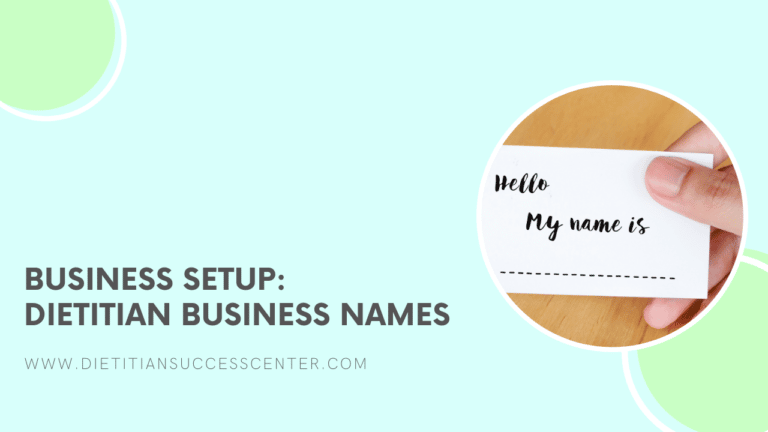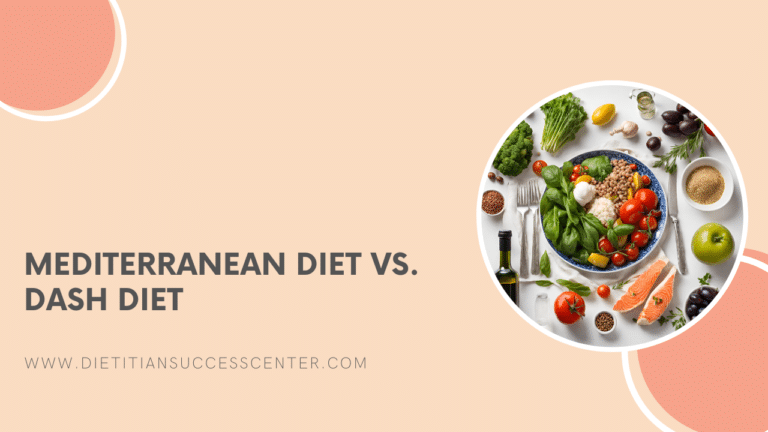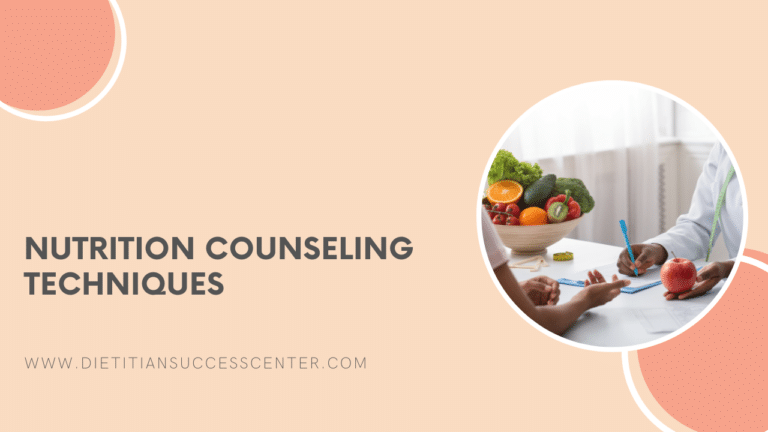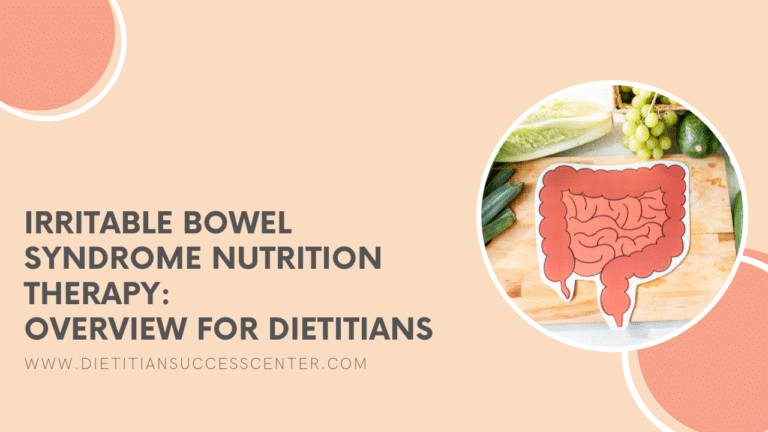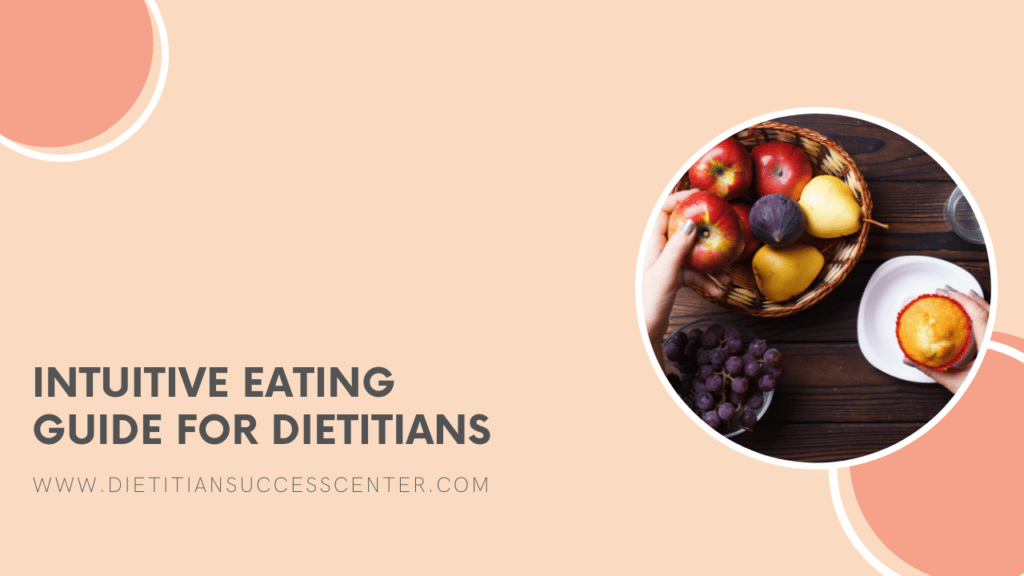

Written by Olivia Farrow, RD, MHSc
Reviewed by Krista Kolodziejzyk, RD, MPH, MBA
Are you a registered dietitian wanting to learn more about intuitive eating and how to support your clients?
This content is based on DSC’s intuitive eating course for dietitians created with support from Abby Hsiao, RD.
Intuitive eating is a concept developed by the dietitians Evelyn Tribole and Elyse Resch (1).
Learn more about intuitive eating, build your intuitive eating counseling skills, and get access to DSC’s ready-to-use intuitive eating handouts and intuitive eating pdf summary sheet by becoming a member of Dietitian Success Center.
Why is it important for dietitians to know about intuitive eating?
How many times do we get asked about diets and weight loss advice from patients, clients, friends, families, co-workers, etc?
Thanks to rampant diet culture, many people engage in disordered eating without knowing they’re doing it (2).
Disordered eating is prevalent (3,4,5,6) and can have enormous health implications and lasting consequences (7,8,9,10). Dietitians play a major role in addressing disordered eating behaviors and protecting our clients and patients from misinformation.
The unfortunate part of all of this is that many dietitians do not receive training during schooling or practical education on how to address disordered eating properly.
Many dietitians feel uneasy about counseling clients who exhibit disordered eating behaviors or want to lose weight badly. It causes a sense of anxiety where we, as dietitians, want to make sure we say the right things to ensure we aren’t causing more harm.
DSC’s Intuitive Eating online course helps dietitians understand how to approach treatment and have conversations with clients about disordered eating and intuitive eating.
Disordered Eating Background
Disordered eating is present when an individual engages in abnormal eating patterns or food behaviors regularly. Eating disorders, however, are psychiatric illnesses in which the individual experiences severe disturbances in their eating behaviors relating to their thoughts and emotions.
The difference between the two is the severity of the behaviors and health consequences. It is important to note that disordered eating is often a precursor for eating disorders (2).
This is where intuitive eating comes in. Intuitive eating principles may help shift someone from disordered eating behaviors to normalized eating patterns (1).
Concepts of Intuitive Eating
Intuitive eating is an evidence-based concept developed by the dietitians Evelyn Tribole and Elyse Resch (1).
There are three key features of intuitive eating.
Naturally intuitive eaters tend to exhibit these behaviors (11):
-
- Unconditional permission to eat
-
- Eating for physical reasons rather than emotional ones
-
- Relying on internal hunger and fullness cues to determine how often, when and how much to eat

Intuitive Eating vs. Dieting
The main difference between intuitive eating versus dieting or weight-centric nutrition recommendations is where the rules are set.
With intuitive eating, the individual pays attention to their internal cues for guidance. This is often accompanied by guiding principles like finding peace, finding what feels comfortable, good, satisfying and what feels natural (1).
That is the opposite message that diet culture gives us. Diet and weight loss recommendations ask the individual to disregard cues from their bodies, whether that’s suppressing their hunger or eating foods they don’t enjoy.
Diet culture often sounds like:
“No pain, no gain”
“You must exercise rigid willpower and control”
“All you have to do is simply follow an external set of rules or goalposts (like a number of calories, macros or a number on a scale) and ignore the signals from your body”.
“You dislike the food? Well too bad, get used to it”
“Use your willpower to suppress your desires”
“You’re still hungry? That’s too bad. You’ve already eaten your limit for today”
Following rigid, external rules can create disordered eating because, the reality is, these rules often conflict with one another:
“I should cut carbs. Oh, but wait, fruit has carbs.”
“Donuts are off-limits, but have a spoonful of manuka honey at breakfast?”
“Should I go keto or go vegan? They seem completely opposite”
“How much exactly do I eat? How often?”
As dietitians, we know that some of these questions have no real answers. It’s impossible to have a rule for every occasion, and every individual’s unique circumstances.
Benefits of Intuitive Eating
The benefits of intuitive eating have been well documented and thoroughly researched and organized by Evelyn Tribole and Elyse Resch (1). We review these benefits in more detail in the DSC Intuitive Eating course for dietitians.
Studies have found that intuitive eaters have less disordered eating, weight bias, and body dissatisfaction (12).
Intuitive eaters also have been found to have lower blood pressure and triglycerides and LDL cholesterol (12). They tend to have higher self-esteem and well-being, more variety and balance in their diet, higher body appreciation, proactive coping skills, and life satisfaction (1,12,13) .
Intuitive eating is where many individuals will find food freedom. They can finally get off the dieting treadmill and be free of the mental distress it causes them.
The 10 Principles of Intuitive Eating
Evelyn Tribole and Elyse Resch developed the 10 principles of intuitive eating (1). Dietitian Success Center’s Intuitive Eating Course for dietitians covers more detail on these principles. It includes an intuitive eating pdf summary sheet and ready-to-use handouts for conversations with your clients about the principles of intuitive eating.
The 10 principles of intuitive eating include (1)
- Reject the Diet Mentality
- Honor Your Hunger
- Make Peace with Food
- Challenge the Food Police
- Discover the Satisfaction Factor
- Feel Your Fullness
- Cope with Emotions with Kindness
- Respect Your Body
- Movement-Feel the Difference
- Gentle Nutrition
Identifying your client’s needs and priorities is important in assessing how to apply the principles of intuitive eating. Which principle you will start focusing on will depend on where your client is in their journey (1). Often rejecting the diet mentality and honoring hunger are the first steps (1).
Applying Intuitive Eating to Dietetic Practice
Learning about the principles of intuitive eating is the first step to feeling more confident with intuitive eating. The DSC Intuitive Eating Course for Dietitians guides you through how to apply intuitive eating in counseling sessions with a thorough case study and tried-and-true advice from dietitian Abby Hsiao.
You also get instant access to intuitive eating resources for dietitians including an intuitive eating pdf summary sheet and client-facing intuitive eating handouts including
-
- 10 Principles of Intuitive Eating
-
- Intuitive Eating Hunger Scale pdf
-
- Food & Mood Diary
-
- Reject the Diet Mentality Handout
-
- Intuitive Eating Gentle Nutrition Handout
-
- Non-Weight Health and Wellness Goals
At DSC, we make it easier for dietitians and dietetic students to build expertise in topics including Intuitive Eating. Our Intuitive Eating online course for dietitians, ready-to-use intuitive eating handouts, intuitive eating pdf summary sheet, and community can help you feel more confident with intuitive eating counseling in your dietetic practice.
Dietitian Success Center is THE professional development resource for dietitians and dietetic students. Our mission is to make it easier for dietitians and dietetic students to build expertise. We do this through evidence-based online nutrition courses, community, and ready-to-use client handouts. Plus – we give you the tools to start and grow your dietitian private practice!
References:
1. Tribole, E. (2020). Intuitive Eating, 4th Edition. St. Martin’s Essentials.
2. Eating Disorders Vs. Disordered Eating: What’s The Difference? (2017, May 22). National Eating Disorders Association. Retrieved April 20, 2021, from https://www.nationaleatingdisorders.org/blog/eating-disorders-versus-disordered-eating
3. Research on ED. NIED. https://nied.ca/research-on-ed/. Published July 14, 2020.
4. Merikangas, et al. (2010). Lifetime Prevalence of Mental Disorders in U.S. Adolescents
5. Prevalence Of Eating Disorders Over The 2000–2018 Period: A Systematic Literature Review. (2019, April 26). OUP Academic
6. Statistics & Research On Eating Disorders. (2018, February 19). National Eating Disorders Association. Retrieved April 20, 2021
7. Montani, J.-P., Schutz, Y., & Dulloo, A. G. (2015). Dieting and weight cycling as risk factors for cardiometabolic diseases
8. Rothblum, E. D. (2018). Slim chance for permanent weight loss. Archives of Scientific Psychology,
9. Quick, V. M., Byrd-Bredbenner, C., & Neumark-Sztainer, D. (2013). Chronic Illness and Disordered Eating: A Discussion of the Literature,\
10. Dulloo, A. G., Jacquet, J., & Montani, J.-P. (2012). How dieting makes some fatter: from a perspective of human body composition autoregulation.
11. Tylka, T. L. (2006). Development and psychometric evaluation of a measure of intuitive eating. Journal of Counseling Psychology
12. Tylka, T. L., Annunziato, R. A., Burgard, D., Daníelsdóttir, S., Shuman, E., Davis, C., & Calogero, R. M. (2014). The Weight-Inclusive versus Weight-Normative Approach to Health: Evaluating the Evidence for Prioritizing Well-Being over Weight Loss. Journal of Obesity, 2014, 1–18. Retrieved April 20, 2021, from 10.1155/2014/983495
13. Bruce, L. J., & Ricciardelli, L. A. (2016). A systematic review of the psychosocial correlates of intuitive eating among adult women. Appetite, 96, 454–472. Retrieved April 20, 2021, from 10.1016/j.appet.2015.10.012


